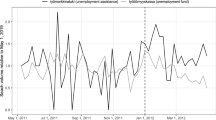Abstract
This paper puts together the non-distortionary liquidity effect of unemployment insurance and job match quality. We identify a big impact on subsidized unemployment duration and a small impact on wages on the job that follows the unemployment spell. Wage gains are heterogeneous and concentrated on individuals at the bottom of the pre-unemployment income distribution. The non-distortionary nature of the liquidity effect reduces the pressure on low-income workers to accept lower productivity jobs.
Access this article
We’re sorry, something doesn't seem to be working properly.
Please try refreshing the page. If that doesn't work, please contact support so we can address the problem.

Similar content being viewed by others
Notes
Using survey data from 1992 to 1997, Addison and Portugal (2007) study the impact of the Portuguese UI rules on transitions out of unemployment into employment. They do not study the impact on reemployment wages.
Within the regression discontinuity design approach, using reemployed workers might generate a selection bias only if it has a different effect on individuals to the left and to the right of the discontinuity threshold. In our case, validity tests for the regression discontinuity approach show no evidence of selection effects on the variables of interest.
The set of control variables included are listed in the notes to Table 2. We experimented with other bandwidths, but the results resemble those reported in the Table.
Notice that the GRR restriction applies only to pre-unemployment income, since in the post-unemployment period, we require only individuals to have a full-time job, meaning that the lower bound of reemployment wages is equal to the minimum wage.
References
Acemoglu D, Shimer R (2000) Productivity gains from unemployment insurance. Eur Econ Rev 44:1195–1224
Addison J, Centeno M, Portugal P (2009) Do reservation wages really decline? Some international evidence on the determinants of reservation wages. J Labor Res (forthcoming)
Addison J, Portugal P (2007) How do different entitlements to unemployment benefits affect the transitions from unemployment to employment? Working paper 11–04, Banco de Portugal
Cahuc P, Zylberberg A (2006) The natural survival of work. MIT, Cambridge
Card D, Chetty R, Weber A (2007) Cash-on-hand and competing models of intertemporal behavior: new evidence from the labor market. Q J Econ 122(4):1511–1560
Centeno M, Novo ÁA (2007) Identifying unemployment insurance income effects with a quasi-natural experiment. Working paper 2007-10, Banco de Portugal
Chetty R (2008) Moral hazard versus liquidity and optimal unemployment insurance. J Polit Econ 116(2):173–234
Eckstein Z, van den Berg GJ (2007) Empirical labor search: a survey. J Econom 136(2):531–564
Fitzenberger B, Wilke R (2007) New insights on unemployment duration and post unemployment earnings in Germany: censored Box-Cox quantile regression at work. IZA Working Paper 2609
Imbens G, Lemieux T (2008) Regression discontinuity designs: a guide to practice. J Econom 142(2):615–635
Lalive R (2007) Unemployment benefits, unemployment duration, and post-unemployment jobs: a regression discontinuity approach. Am Econ Rev 97(2):108–112
Lalive R (2008) How do extended benefits affect unemployment duration? a regression discontinuity approach. J Econom 142:785–806
Lancaster T (1992) The econometric analysis of transition data. Cambridge University Press, Cambridge
Lee DS (2008) Randomized experiments from non-random selection in U.S. House elections. J Econom 142(2):675–697
Marimon R, Zilibotti F (1999) Unemployment vs. mismatch of talents: reconsidering unemployment benefits. Econ J 109:266–291
Mortensen D (1986) Job search and labor market analysis. In: Ashenfelter O, Layard R (eds) Handbook of labor economics, vol. 2. North-Holland, Amsterdam, pp 849–919
van den Berg GJ (1990) Nonstationarity in job search theory. Rev Econ Stud 57(2):255–277
Ziliak JP (2003) Income transfers and assets of the poor. Rev Econ Stat 85(1):63–76
Author information
Authors and Affiliations
Corresponding author
Additional information
We thank Instituto de Informática (II) of the Portuguese Social Security for making the data available to us, in particular, João Morgado for insightful discussions. Opinions expressed herein do not necessarily reflect the views of the Banco de Portugal and II. Any errors are of our responsibility. The financial support of FCT (Fundação para a Ciência e a Tecnologia), Portugal, through UECE (Research Unit on Complexity and Economics) is acknowledge. This article is part of the Multi-annual Funding Project (POCTI/0436/2003).
About this article
Cite this article
Centeno, M., Novo, Á.A. Reemployment wages and UI liquidity effect: a regression discontinuity approach. Port Econ J 8, 45–52 (2009). https://doi.org/10.1007/s10258-009-0038-8
Received:
Accepted:
Published:
Issue Date:
DOI: https://doi.org/10.1007/s10258-009-0038-8
Keywords
- Unemployment insurance
- Subsidized unemployment duration
- Reemployment wages
- Liquidity effect
- Regression discontinuity




